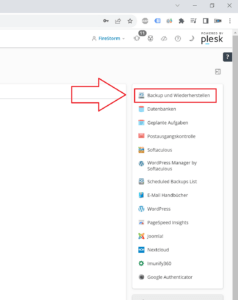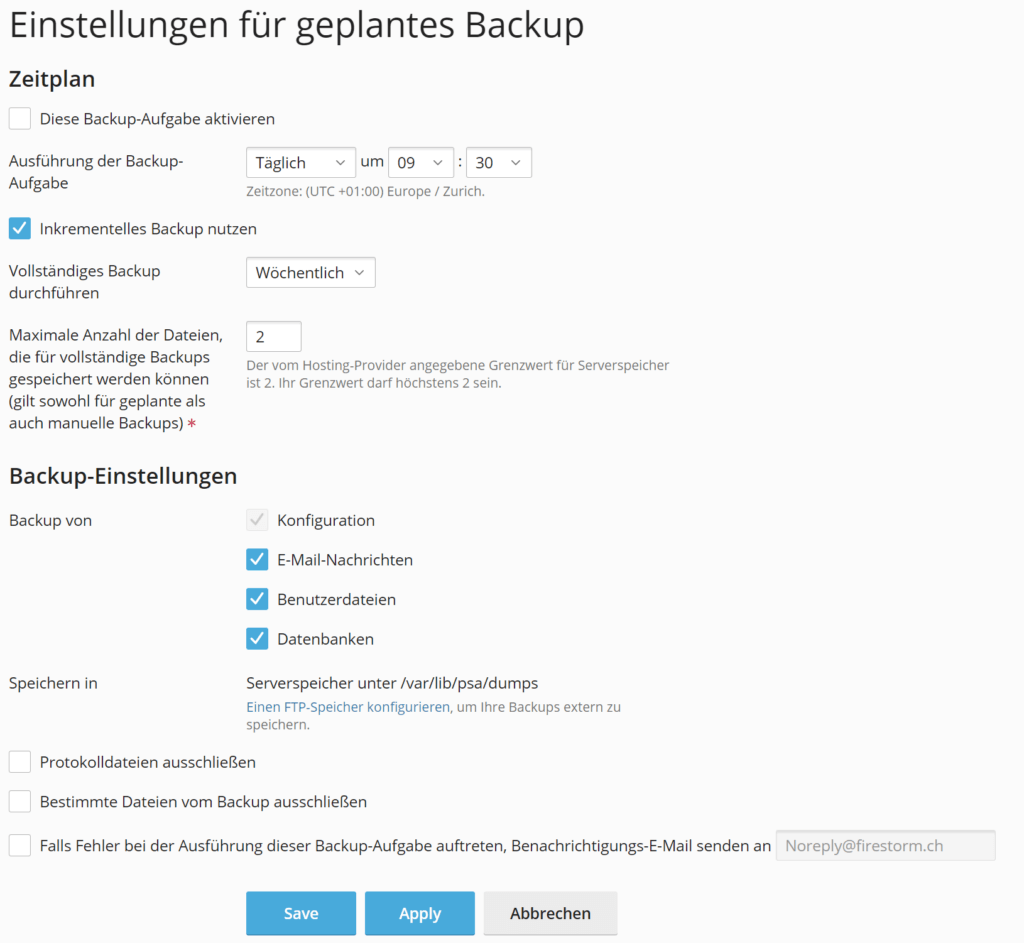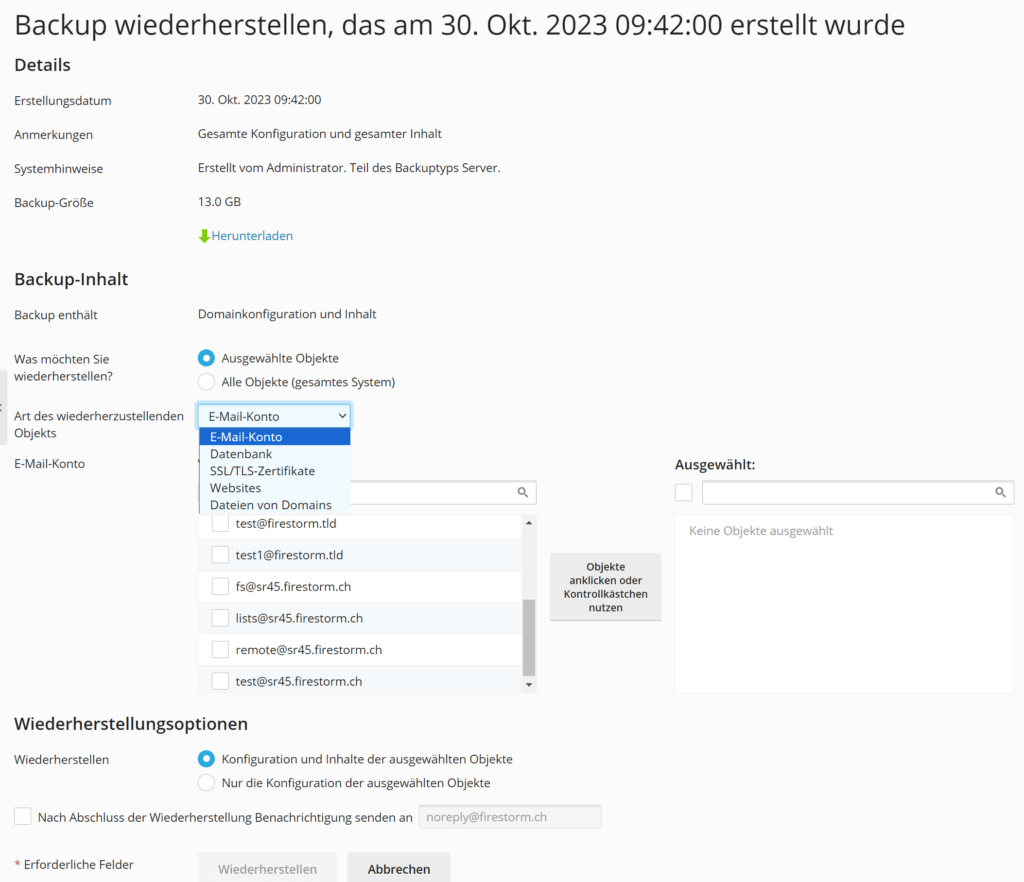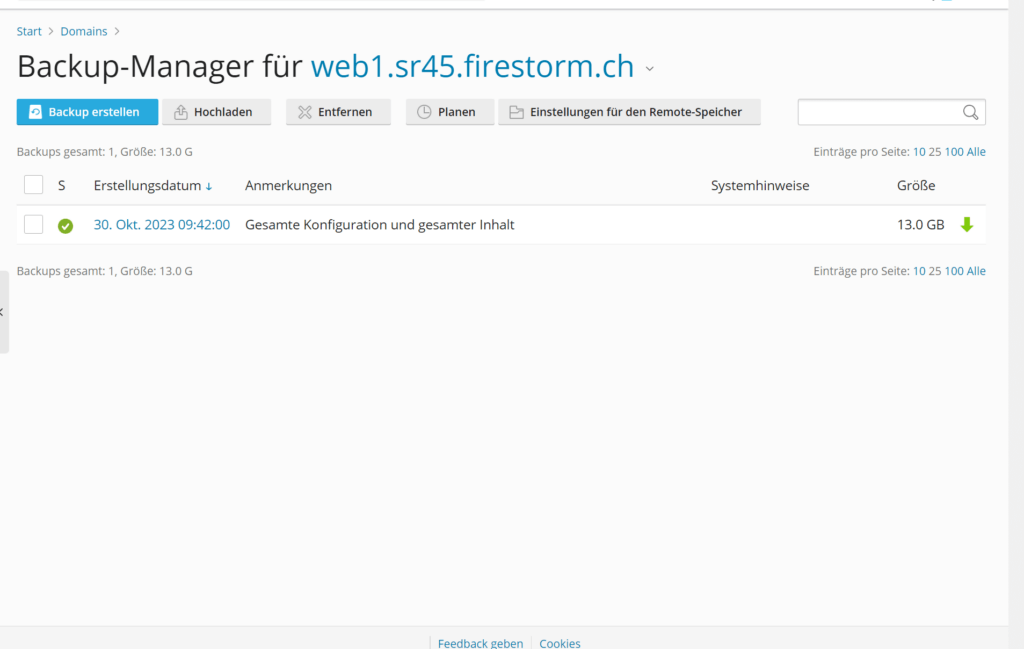Plesk Backup Manager
Support Wissensdatenbank
Plesk Backup Manager
With the Plesk Backup Manager, you can create regular backups of your website, settings, and email accounts. Please note that FireStorm automatically creates a backup of all your data twice daily and distributes the backups to two data centers. So, it’s not strictly necessary to create additional backups, but it is recommended, especially before making significant changes to your website. Also, keep in mind that the backup counts towards your storage space.
In the Plesk Backup Manager, you have the option to create both full and incremental backups of your data and mailboxes. You can store the data on the local server storage or an external FTP server. These backups can be created as one-time copies or on a scheduled and regular basis. The number of backups is limited to two.
- One-Time Backups
Create a Backup
Log in to the hosting control panel Plesk.
Click on ‘Backup Manager’ in the right-hand menu.
Then click on ‘Create Backup.’
- Automatic Regular Backups
- Go to Tools & Settings > Backup Manager (under “Tools & Resources”).
- Leave the checkbox “Enable this backup task” selected and provide the following details:
- Specify when and how often you want the backup to run under “Execution of the backup task.”
- By default, “Use Incremental Backup” is selected to reduce storage space and backup duration (details can be found in Incremental Backup).
- Choose how often full backups should be performed next to “Perform Full Backup.” The available values depend on the time frame selected under “Execution of the backup task.”
- To automatically delete old backups, specify the maximum number of full backup files to retain (including scheduled and manual backups). More details can be found under Backup Rotation.
- Choose what data to back up next to “Backup from.” You can either back up settings only or both settings and user data. For more information about the data included in backups, refer to Backup and Restoration.
- You will see the local storage path under “Store in,” where Plesk stores backups. To configure remote storage, click on the corresponding link.
- If you have configured remote storage, you can split backup files. To do this, check the “Create backup spanning multiple volumes, volume size (MB)” box and specify the volume size in megabytes.
- To exclude all log files from backups (including logs from the system directory), check the “Exclude log files” box.
- You may also want to exclude certain files and directories from backups, such as temporary file directories or files to which you do not have access (to prevent errors). To do this, check the “Exclude specific files from the backup” box and then specify the files and directories you want to exclude.
Provide the files or directories following these rules:
- Separate files with a new line or a comma.
- Use “” to replace any character except “/” in the file or directory name. For example: /Folder//Logs refers to the Logs directory in any subdirectory of the Folder directory, /Folder/Log* refers to files and directories starting with Log in the Folder directory, */Logs refers to the Logs directory in any subdirectory in the subscription’s root directory.
- Use “**” to replace multiple repeated characters or directories. For example: **/Logs points to the “Logs” directory in a series of subdirectories in the subscription’s root directory.
- Directory paths should not be “.”, “..,” or contain special characters like “t” or “n.”
Note: The options “Exclude log files” and “Exclude specific files from the backup” are only available if you have selected the “User files and databases” option.
To receive email notifications if anything goes wrong during the backup, check the “Send a notification email in case of backup task execution failure” box. Plesk will suggest the email address provided in your profile. Change the email address if necessary.
- Restoring Backups
Open the Backup Manager.
Click on the creation date to initiate a direct restoration.
Choose what you want to restore. You can restore all objects or select specific objects such as domain configurations, files, databases, email accounts, etc. You can specify the respective email address or folder to be restored in the lower field. You can also download the backup and open it on your PC, for example, with WinRAR
- Deleting Backups
To delete a backup, select the checkbox on the left and click “Remove” at the top. For incremental backups, you must first delete all incremental backups before the main backup can be deleted.





